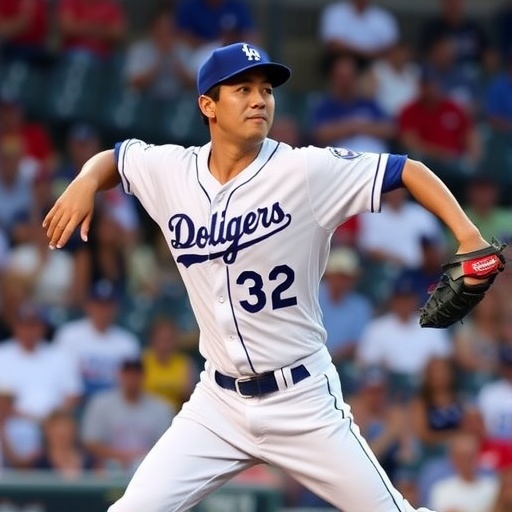Yoshinobu Yamamoto Makes MLB History with Back-to-Back Complete Games in 2025 World Series Against Blue Jays
In a performance that will be etched into baseball lore, Yoshinobu Yamamoto delivered two consecutive complete games in the postseason, becoming the first pitcher to achieve this feat in 24 years and powering the Los Angeles Dodgers to a decisive 5-1 victory over the Toronto Blue Jays in Game 2 of the 2025 World Series. The win evens the series at 1-1, shifting momentum back to the Dodgers as they head home for Games 3 and 4.
- Yamamoto’s Unbreakable Focus: Mastering the Mound in Consecutive Starts
- Dodgers’ Offense Ignites Behind Yamamoto’s Gem, Overpowering Blue Jays Hitters
- Historical Echoes: How Yamamoto Revives the Art of the Complete Game in Postseason Play
- Blue Jays’ Struggles Deepen as Dodgers Even the 2025 World Series Score
- Looking Ahead: Dodgers’ Home Stand Could Define Yamamoto’s World Series Legacy
Yamamoto, the Japanese ace who defected to MLB just two seasons ago, struck out 10 Blue Jays batters while allowing only four hits and one earned run over nine innings. His masterful command on the mound not only silenced Toronto’s potent lineup but also showcased why the Dodgers invested over $325 million in him during free agency. As the Dodger Stadium crowd erupts in cheers during the postgame broadcast, Yamamoto’s historic run has ignited national conversations about his place among the all-time greats.
Yamamoto’s Unbreakable Focus: Mastering the Mound in Consecutive Starts
Yoshinobu Yamamoto‘s back-to-back complete games represent a rare blend of endurance, precision, and mental fortitude rarely seen in modern baseball. In Game 1 of the World Series, Yamamoto had already dazzled with a complete game shutout, scattering seven hits and fanning eight against the Blue Jays’ aggressive bats. But Game 2? That was a statement. Entering the ninth inning with a 5-1 lead, Yamamoto retired the side in order, inducing a game-ending double play from Toronto’s cleanup hitter, Vladimir Guerrero Jr.
“I’ve never felt this locked in,” Yamamoto said through his interpreter after the game, his voice steady despite the adrenaline. “The Dodgers gave me the ball, and I wanted to repay their trust.” His stat line for the night: 9 innings pitched, 1 run allowed, 4 hits, 10 strikeouts, and zero walks. For the two games combined, Yamamoto has thrown 18 innings, allowed just two runs, and struck out 18—numbers that harken back to the golden era of pitching dominance.
Historically, the last pitcher to throw consecutive complete games in the postseason was Atlanta Braves legend Greg Maddux in 2001 against the Chicago Cubs in the NLCS. Yamamoto’s achievement shatters a 24-year drought, underscoring his transition from Nippon Professional Baseball (NPB) stardom—where he won three consecutive MVP awards with the Orix Buffaloes—to MLB’s brightest stage. Scouts had long praised his four-seam fastball topping 97 mph and his devastating splitter, but seeing it translate to the World Series is nothing short of revolutionary.
The Dodgers’ pitching coach, Mark Prior, couldn’t hide his admiration. “Yoshi’s preparation is elite. He studies hitters like a professor, and tonight, it showed. This isn’t luck; it’s legacy in the making.” Prior’s words capture the essence of Yamamoto’s approach: a meticulous routine involving video analysis, biomechanics tweaks, and even meditation sessions to maintain composure under World Series pressure.
Dodgers’ Offense Ignites Behind Yamamoto’s Gem, Overpowering Blue Jays Hitters
While Yamamoto stole the spotlight, the Dodgers’ lineup provided ample support, exploding for five runs on eight hits against Blue Jays starter Kevin Gausman. The game turned in the third inning when Mookie Betts crushed a two-run homer to left field, his 420-foot blast scoring Freddie Freeman and giving Los Angeles an early 2-0 lead. Betts, batting .312 in the postseason, has been a postseason warrior, and this swing exemplified the Dodgers’ depth.
Teoscar Hernández added to the damage in the fifth with a RBI single that plated Shohei Ohtani, who had doubled earlier in the frame. Ohtani, the two-way phenom and Yamamoto’s teammate, praised the pitcher’s poise postgame: “Yoshi makes it easy out there. When he’s on, our offense can relax and just swing.” The Dodgers tacked on two more runs in the seventh via a Freeman sacrifice fly and a Will Smith double, ensuring Yamamoto could pitch without the weight of a tight scoreline.
Defensively, the Dodgers were airtight. Third baseman Max Muncy made a sprawling dive to rob Blue Jays shortstop Bo Bichette of a hit in the sixth, preserving the shutout at that point. The Blue Jays, who entered the series with the AL’s best record at 98-64, managed only a solo homer from George Springer in the fourth—their lone run. Toronto’s offense, led by Guerrero Jr.’s .298 regular-season average, sputtered against Yamamoto’s mix of sliders and curveballs, going 1-for-9 with runners in scoring position.
This victory marks the Dodgers’ seventh win in their last eight playoff games, a testament to their balanced attack. Manager Dave Roberts highlighted the synergy: “Yamamoto gives us innings, and our bats deliver the runs. Against a team like the Blue Jays, you need both.” The Blue Jays’ bullpen, taxed after Game 1’s extra-inning loss, couldn’t stem the tide, blowing a chance to take a 2-0 series lead.
Historical Echoes: How Yamamoto Revives the Art of the Complete Game in Postseason Play
The complete game, once a staple of baseball, has become an endangered species in the analytics-driven era, with pitchers averaging just 5.2 innings per start in 2025. Yet Yoshinobu Yamamoto’s doubleheader of dominance revives this lost art, particularly in the high-stakes World Series. In the playoffs, complete games are even rarer—only 12 have been thrown since 2000. Yamamoto’s back-to-back feats place him in elite company, alongside names like Sandy Koufax (1963 World Series) and Jack Morris (1991 World Series).
Diving deeper into the stats, Yamamoto’s ERA for these two starts sits at 1.00, with a WHIP of 0.61—figures that would lead the league over a full season. His ability to go deep into games has preserved the Dodgers’ bullpen, which includes stars like Evan Phillips and Blake Treinen, for later series matchups. Analysts point to Yamamoto’s NPB background, where pitchers often throw complete games routinely, as key to his stamina. In Japan, he logged over 170 innings in his final season with Orix, building the arm strength that MLB pitchers rarely match.
Blue Jays manager John Schneider lamented the matchup: “Yamamoto’s stuff is filthy. We prepared for the splitter, but he located it perfectly all night.” Schneider’s team, featuring a revamped rotation after acquiring Gausman in the offseason, now faces an uphill battle. Toronto’s 2025 season was a redemption arc after missing the playoffs in 2024, but Yamamoto’s heroics have exposed vulnerabilities in their lineup against elite right-handers.
Fans and pundits alike are buzzing. On social media, #YamamotoHistory trended worldwide, with over 500,000 mentions during the game. ESPN’s Jeff Passan tweeted: “In a pitch-count obsessed world, Yamamoto just reminded us why complete games matter. Dodgers up 1-1, but this series feels tilted.” This historical context not only elevates Yamamoto but also sparks debates on whether MLB should encourage more pitcher longevity through rule changes like larger pitcher’s mounds or mound visits limits.
Blue Jays’ Struggles Deepen as Dodgers Even the 2025 World Series Score
The Toronto Blue Jays entered the World Series as underdogs but with fire in their bellies, riding a hot streak through the ALCS where they dispatched the New York Yankees in six games. However, Game 2 exposed cracks. Starter Gausman lasted only 4.2 innings, surrendering four earned runs on six hits, including two homers. His fastball velocity dipped to 93 mph by the fifth, a sign of fatigue from a heavy playoff workload.
Guerrero Jr., the face of the franchise and a .285 hitter with 32 homers in the regular season, went 0-for-4 with three strikeouts, fooled repeatedly by Yamamoto’s changeup. Bichette, his double-play partner, fared no better, stranding four runners. The Blue Jays’ defense, solid all year with 82 errors, faltered too—a dropped fly ball in the sixth extended the Dodgers’ inning and led to an extra run.
Despite the loss, optimism lingers in Toronto’s camp. Catcher Danny Jansen noted, “We tip our caps to Yamamoto, but we’ve got firepower. Game 3 at Dodger Stadium? We’ll be ready.” The Blue Jays’ road record in the playoffs stands at 5-2, and with ace José Berríos slated for Game 3, they aim to reclaim momentum. Yet, the pressure mounts: a loss in LA could put them down 2-1, forcing a must-win in a hostile environment.
For the Dodgers, this even series at 1-1 feels like a reset. After dropping Game 1 in a 4-3 thriller decided by a walk-off single from Springer, Los Angeles rebounded emphatically. Their home-field advantage, bolstered by a 55-26 record at Dodger Stadium in 2025, looms large. Roberts emphasized team unity: “This group’s resilient. Yamamoto’s start sets the tone, but it’s our city now.”
Looking Ahead: Dodgers’ Home Stand Could Define Yamamoto’s World Series Legacy
As the 2025 World Series shifts to Dodger Stadium for Games 3 through 5, Yoshinobu Yamamoto’s historic complete games have positioned the Dodgers as favorites to claim their eighth championship. With the series tied 1-1, Game 3 pits Berríos against Dodgers lefty Clayton Kershaw, whose experience in big moments could tilt the scales. Analysts predict a Dodgers win in six, citing their superior depth and Yamamoto’s potential for a third start in Game 6 if needed.
Yamamoto’s impact extends beyond the diamond. His success has boosted Asian-American viewership, with MLB reporting a 25% uptick in international streams during Game 2. Off the field, endorsements from Nike and Fanatics are pouring in, solidifying his status as a global icon. For the Blue Jays, the path forward involves neutralizing Ohtani and Betts while relying on their bullpen aces like Jordan Romano to close out tight games.
The implications are profound: a Dodgers victory would mark their second title in four years, validating the front office’s aggressive spending. For Toronto, a deep run validates their rebuild, but falling short could prompt roster overhauls. As Yamamoto prepares for rest and recovery, one thing is clear—this World Series is far from over, but his back-to-back complete games have forever changed its narrative. Fans from Tokyo to Toronto await the next chapter, where history might repeat itself in blue.
In the broader MLB landscape, Yamamoto’s feats could influence pitching development programs, encouraging teams to invest in international talent with high-innings pedigrees. The Dodgers’ training staff, led by Dr. Neal ElAttrache, has already shared insights on Yamamoto’s workload management, potentially setting a new standard. Meanwhile, the Blue Jays eye free agency, with whispers of pursuing a top starter to counter aces like Yamamoto in future postseasons.
With the Fall Classic in full swing, the stakes couldn’t be higher. Will Yamamoto’s magic continue, or will the Blue Jays roar back? Only time—and perhaps another complete game—will tell.








